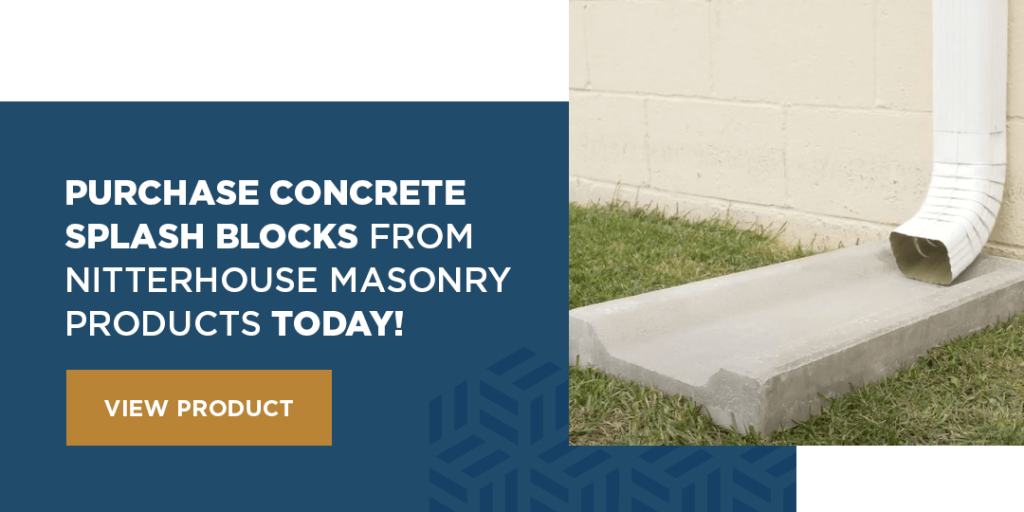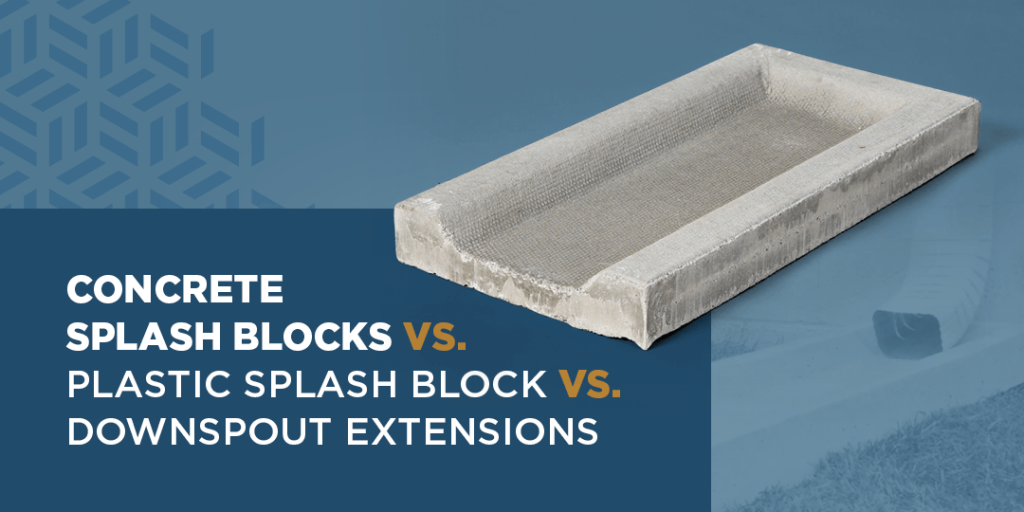
Gutter systems on buildings control the flow of water from the roof to the ground. The gutters help prevent ground erosion from water flowing directly off the roof. However, these systems are useless if you don’t have a means of directing water away from the downspout. Uncontrolled water flow from the downspout puts all the roof’s water into one spot, close to the foundation, which negates the benefits of the gutter system.
Splash blocks and downspout extensions are some of the most common solutions to this problem. Discover the right choice for your home by comparing concrete splash blocks vs. downspout extensions vs. plastic splash blocks. Knowing the pros and cons of each will help you to make the most informed decision to protect your home’s foundation.
View Our Selection of Concrete Splash Block
Concrete Splash Blocks vs. Plastic Splash Block
Generally, you can break down options for controlling water flow from downspouts into two categories – splash blocks and downspout extensions. Within the former group, you have concrete and plastic options. Comparing plastic splash block vs. concrete splash block is easier than many people think because these two materials have significant differences in performance:
Plastic may cost less in some cases. However, the plastic blocks also weigh less. Heavy winds or lawn care equipment could move or damage them.
Concrete splash blocks are heavy, durable and long-lasting for top performance with minimal maintenance. While both channel water away from the home, in a direct comparison of plastic block vs. concrete block, the latter wins out for durability.
Plastic Splash Block vs. Downspout Extensions
Which option comes to the top when comparing plastic splash blocks and downspout extensions? Both have similar issues of potentially becoming displaced or damaged by lawncare equipment. Downspout extensions require more installation work than splash blocks, especially if you choose an underground trenching option. However, downspout extensions also work extremely well in moving water away from the house, as long as they stay intact.
If you want something easy to install, plastic splash blocks win out over downspout extensions.
Downspout Extensions vs. Concrete Splash Blocks
Downspout extensions have various forms to accommodate drainage needs. Flexible models can deliver water around corners, but the bends can clog. Self-extending models automatically unfurl when the water coming through the downspout reaches a high enough flow. Once extended, they stretch out to deliver water away from the home. If the water coming from the downspout is not enough, the extender could remain curled up, preventing the water from leaving the downspout at all. Most extenders for downspouts have a lightweight construction that readily sustains damage from trimmers, mowers or feet.
Concrete splash blocks deliver the flow of water from the downspout away from the foundation. When properly installed and used, these downspout extension alternatives work reliably to carry rainwater from light showers or heavy thunderstorms away from the home. With narrow models for dryer climates and wider options for areas that regularly have heavy rain, concrete splash blocks offer a durable alternative to downspout extensions.
When choosing concrete splash blocks or downspout extensions, consider that the latter can easily sustain damage and may not perform as expected in light rainfall. Concrete splash blocks offer the toughness needed for any addition to the landscape that must withstand battering from the elements and lawn equipment.
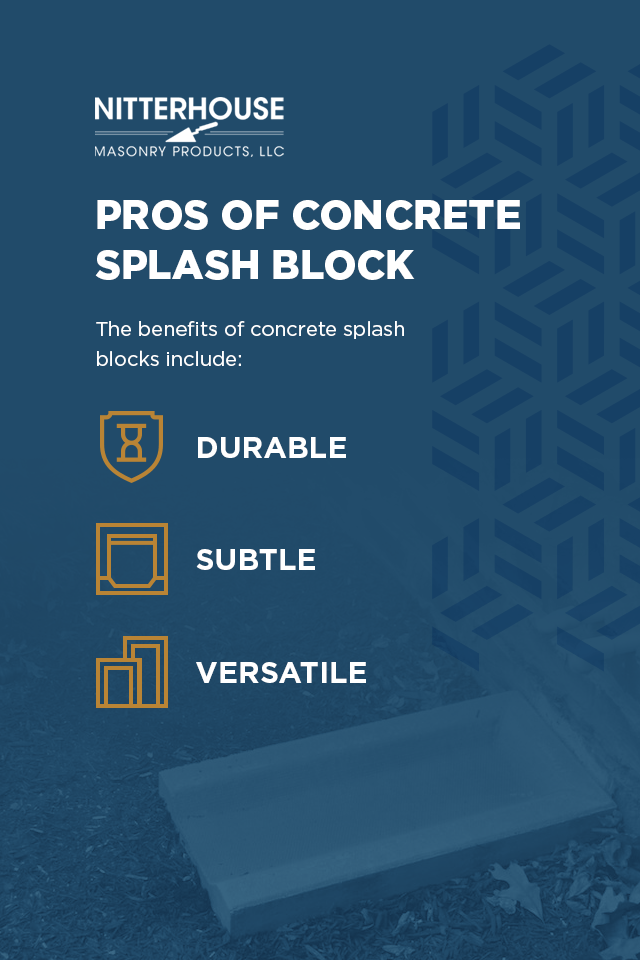
1. The Pros and Cons of Concrete Splash Block
Concrete splash blocks provide homeowners with a way to divert water away from foundations. To work properly, you should choose a length that best fits the arrangement of the area around your downspout and the rainfall you get. Longer splash blocks move more water further from the house. However, these can be difficult to hide. Smaller splash blocks are easier to hide by planting shrubs next to them, but they don’t deposit water as far from the house.
Once you decide on the right balance of size to the appearance of your splash block, you must install it correctly. The closed end of the concrete block goes toward your home, with the open end facing away. Angle the block slightly so the side closest to the house is raised to create a downward slope to direct the water away more easily from your home. Corrected sized and placed concrete splash blocks provide you with multiple benefits for years while minimizing the downsides to these home protectors.
Pros of Concrete Splash Block
The benefits of concrete splash blocks include:
- Durable: The extra weight of concrete splash blocks is a perk that some consider a downside. The weighty construction gives these splash blocks durability to function well for years. They also remain firmly in place, even in high winds or from getting hit by lawncare equipment.
- Subtle: Another benefit of concrete splash blocks is their subtle appearance. Their concrete construction makes them look like another structure in the garden. Plus, they have low enough profiles to not distract from the surrounding area. Those who don’t like the appearance of the splash guards can use shrubs and other small, low-profile plants. These growths easily hide the locations of the blocks.
- Versatile: Concrete splash blocks have several size options, giving you a range of choices to fit your yard and home. Homes with these splash guards at the downspouts also look better because they don’t have mud splatters on the wall next to the downspout. The splash block sends water away from the home and its walls, preventing the mud splatters that make a home look dingy.
Of course, the best advantage of using concrete splash blocks is the improved drainage you will get around your home. The splash blocks safely and reliably channel water away from your home. Their performance at diverting water away from your house can prevent foundation damage and leaks into the basement. These benefits could save you thousands of dollars in future repairs.
Cons of Concrete Splash Block
Concrete splash blocks are very heavy, which may make installing them without assistance difficult. Larger sizes weigh more. For instance, 2-foot splash blocks weigh 50 pounds, while 4-foot blocks weigh 110-pounds.
Don’t let the heft of these blocks dissuade you from using them. These weights serve as an advantage to using concrete splash blocks. Since they weigh so much, they remain firmly in place once you’ve correctly put them beneath your downspouts.
2. The Pros and Cons of Plastic Splash Block
Plastic splash blocks may appear the same as concrete versions. However, plastic blocks have lighter construction. They may have similar designs to concrete splash blocks, but they do not have the same pros and cons. When you want to get splash block, carefully consider the advantages and disadvantages of plastic before deciding to use this option over concrete.
Pros of Plastic Splash Block
Plastic splash blocks do provide quality drainage of water away from your home’s downspouts. When these splash blocks work, they can offer similar protection for your home as concrete blocks. Some benefits include:
- Versatile: Plastic splash blocks have a wide variety of shapes and sizes to accommodate the needs of various homeowners. You can even find different colors of plastic blocks to better blend into your landscape. This variety allows homeowners to find the most aesthetically pleasing splash block to place in or near a garden. Other options, such as dark green or black coloring, allow for better camouflage in the yard to keep others from seeing the splash block.
- Cost-efficient: These splash protectors have budget pricing. Financially minded homeowners often choose these blocks for this reason. The cost comes from the lighter weight, which costs less to ship compared to concrete.
- Lightweight: Plastic blocks are easier to carry around a yard and place at downspouts. Their lightweight makes installing several of these without assistance simple and fast. However, despite the fast installation and low weight of these splash blocks, they may not be the best option due to their downsides.
Whether you use splash blocks made of concrete or plastic, you can enjoy the benefits of preventing soil erosion, avoiding mud splatters on your home and keeping your foundation safe from water damage.
Cons of Plastic Splash Block
Disadvantages of plastic splash blocks come from their construction. The lower weight of these blocks makes it possible that very heavy rains, mowers, leaf blowers or trimmers could move the blocks from their correct positions. Unless you notice the movement right away and move the block back into place, it won’t move water away from the home as intended.
Additionally, plastic is not as durable as concrete. Therefore, a mower could damage the material of the splash block. If the material cracks, some water will seep through those cracks, preventing proper drainage. The cracks will also compromise the integrity of the plastic, putting the splash block at risk of breaking completely. Thinner, lighter plastics are more likely to have such severe consequences from cracks in the splash block than thicker, heavier material.
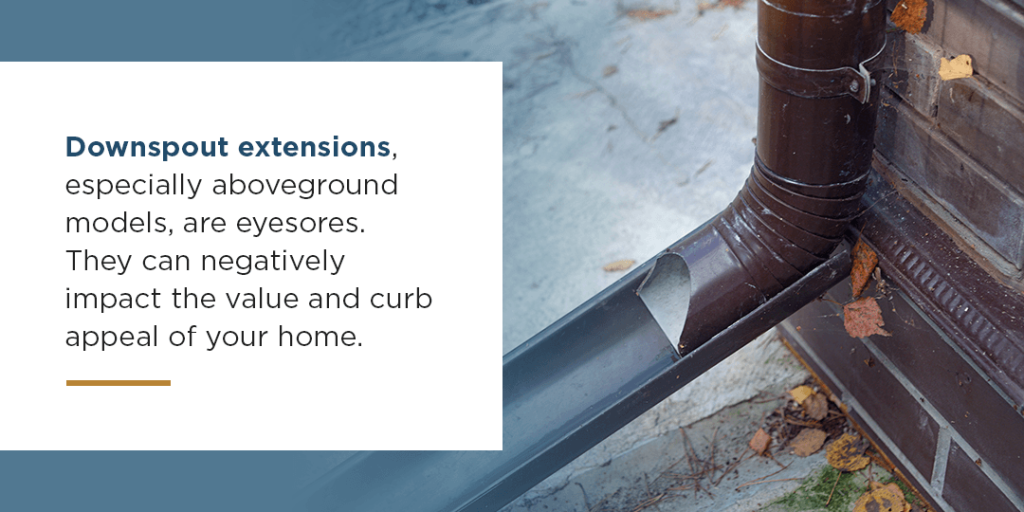
3. The Pros and Cons of Downspout Extensions
Downspout extensions work by lengthening the downspout to carry water from the gutter system several feet away from the house. These extensions can be underground or above ground and come in many formats. You have options that roll back into place when not in use and those you manually lower. Each of these types of extensions brings specific advantages and disadvantages.
Pros of Downspout Extensions
The greatest among the benefits of downspout extensions is their ability to take water far away from your home’s foundation due to their length.
- Installation: These spouts also give you the option to have them easily installed above ground or entrenched underground to protect them from damage. Both above and below ground options can take water directly to a drain or pond in your yard.
- Options: Flexible models let you curve the extender to deliver the water to a place that does not lie in a straight line from the downspout. Flip down and rollout types stay close to the house until it rains. Rollout types will extend from the water pressure, like a party noisemaker when someone blows in it. Flip-down models require manual opening, letting you choose when to open or close them.
Some homeowners pair downspout extenders to take water to a better part of their yard and have the extension deliver the water into a splash block to prevent soil erosion.
Cons of Downspout Extensions
The downsides to downspouts come from their large size. Aboveground extensions have aluminum construction that can easily become flattened from getting run over by a mower, bicycle or person walking. Flexible designs can have mud or debris buildup in the elbows, eventually causing blockages in the line.
Underground downspout extensions may avoid the issues of damage that aboveground models sustain. However, this type of installation requires digging into your yard, which likely requires a call to your local utility providers to avoid digging into an area of underground utility lines. Plus, tree roots may move or damage these underground extensions without notice.
Lastly, downspout extensions, especially aboveground models, are eyesores. They can negatively impact the value and curb appeal of your home. People want to know that a home they are buying will have good drainage, but they don’t want to see pipes extending from their home where they can trip on them in the yard.
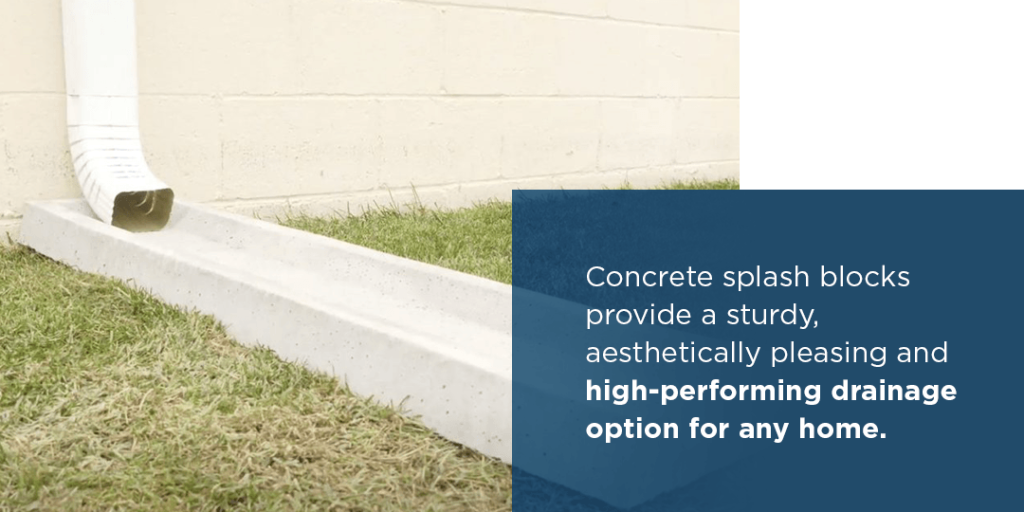
Why You Should Choose Concrete Splash Blocks
Concrete splash blocks provide a sturdy, aesthetically pleasing and high-performing drainage option for any home. These splash blocks don’t break down or fade in the sun as some plastic blocks might. Plus, they can stand up to impacts from rocks, lawn care equipment, people stepping on them and leaf blowers.
Unlike flip-down downspout extensions, you don’t have to go outside before every rainstorm to set up your concrete splash blocks. They are always ready to perform in light rain showers or heavy thunderstorms.
Concrete is sturdy and can stand up to weather extremes, so you can leave your splash blocks in place all year long, through rain or snow. They also require minimal care and remain stable and in place for years.
If you want a drainage solution that can handle a variety of precipitation levels, lasts for years and is durable, you should choose concrete splash blocks. Your landscape will look better. Plus, you will prevent mud splatters on your home, avoid water seepage into your basement and protect your foundation from water damage. With a small investment in concrete splash blocks at each of your downspouts, you can save yourself thousands of dollars in foundation or basement repairs.
Purchase Concrete Splash Blocks From Nitterhouse Masonry Products Today!
Don’t let your downspouts cost you money in foundation repairs or loss of home value. At Nitterhouse Masonry Products, our concrete splash blocks have sturdy construction that won’t blow away in even the strongest winds. Plus, they last for years without maintenance. The small addition of these blocks at your downspouts will make a big difference in preserving the appearance and value of your home. Why wait to start protecting your home? Get quality, durable concrete splash blocks from Nitterhouse Masonry Products today.


